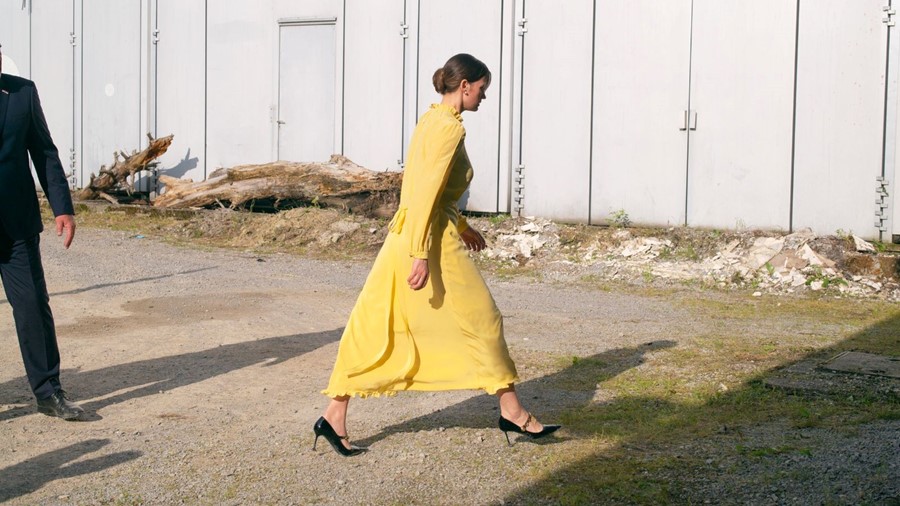As her short film Stane premieres at Venice Film Festival, AnOther catches up with Antoneta Alamat Kusijanović about her tale of a construction businesswoman trying to make it in New York City
As the 26th commission for Miu Miu Women’s Tales, director Antoneta Alamat Kusijanović’s short film Stane continues the cinematic series’ exploration of embodiments of femininity and vanity in the 21st century. Set against the brute backdrop of a New York City building site, the film follows Stane, a woman who has been tapped on the shoulder by her Croatian father to take over the family construction business. A searing conversation around tenets of power unfurls, as Kusijanovic considers its different textures within gender, family, culture.
Stane is played by Danica Curcic, who Kusijanović knew she wanted to work with from the get-go. “I did my last film [Murina] with her, and I knew that we had more to explore together,” she explains. For the family, “I worked with the casting director Timka Grin – we wanted a certain tension that was apparent just by putting the faces together.” From these characters (and spot-on casting), Kusijanović delicately teases out the nuances of emotion and relationships to elaborate a soul-piercing narrative.
Below, AnOther caught up with the director before the film’s release at the Venice Film Festival.
Madeleine Rothery: There is so much to be felt personally in watching Stane – what was the premise for the film?
Antoneta Alamat Kusijanović: I worked in the construction industry in New York, just a few years after I moved there – that’s obviously the setting. And being an immigrant for a number of years gave me an understanding as to how it feels to be within a certain world’s diaspora in the shadow of a big city. How people hold this diaspora together in the most beautiful and the most toxic ways. It’s like a country and a family in a really small pool which makes the dynamics so much more apparent. And I guess I’m interested in a certain type of isolation, in the sense of being surrounded by so many people but being isolated because you create a circle around you.
There was also the question of power. In recent years, we always talk about how we need to give women power, we need to put women in power – but that ‘we’ is always the power behind the power. If you put someone in power, you can then take it away whenever you decide. So, is that true autonomy in power? Times are changing but these are positions where a woman’s power can still be managed. It’s a ‘trick’ that I find very funny, very humiliating.

MR: The film is shot through the main character Stane’s perspective. What does she embody for you?
AAK: What I like about Stane is that there’s so much hope. For me, the emotion gives a sense of something perpetual, a circular flow, like water. But it’s a force that pushes her forward. Also, in the process there was so much hope – working with my team, with wonderful collaborators, the beautiful film crew in Croatia. It felt like this short film was somehow healing.
MR: You can sense that it was a real team production.
AAK: Absolutely. I could keep on repeating it, but [filmmaking] really is witchcraft! You have a spell, but everybody contributes with their own laughter, pain, tears, sweat, joy, blood. It affects everyone and then hopefully continues affecting others. It’s very collaborative. You really need an energy, a force on set to birth the totem, the animal – whatever you want to call it.
The most thrilling part about making a film is that you have a very precise plan going in, but you must also be ready for a storm. The storm is something different every time and that’s the thrilling part – it brings something you could not have planned. You need to know how to swim with the synchronicities and unexpected hardships. When you are lucky enough to have people like I had on both my crew and the amazing Miu Miu team, when all that clicks together, you just feel a palpable love that cuts through it all.

MR: Stane’s outfits are so precise – the Miu Miu collection fits her perfectly. How did you choose her costumes?
AAK: When [costume designer] Amela Bakšić and I saw the collection, we were amazed because there was such a connection between the materials and this boxy, heavy, masculine side of Stane. But then there was something also so delicate and feminine, alluring from within. There’s no better way to describe Stane. All the shields that she puts up to compete in this world and then her personal, emotional struggle as a woman – it was all already there in the clothes.
There is something uncanny about her yellow dress. When we saw it, we said, “Okay, this feels like a late first communion.” But the movement in it was so fluid. Once Stane takes power, the dress all of a sudden has purpose. The best of her was accentuated not in showing, not in beauty, but in acting … in stepping out with her right foot.
Stane premiered at the Venice Film Festival on September 3. It’s now available to watch on MUBI and YouTube.
